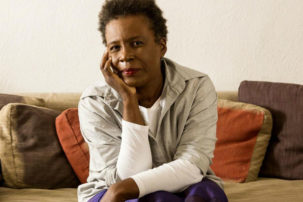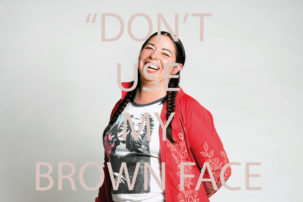At the time I met with Amy Fung to discuss the 30th anniversary of Images Festival, you couldn’t scroll through social media for a split second without coming up against debates about the Whitney Biennial’s divisive Dana Schutz painting of Emmett Till’s open casket. Some called for the destruction of the white artist’s abstraction of a black teenager’s mutilated body. Its defenders cried “censorship!” and lauded its formalist qualities, or at least the necessity of upholding free speech.
“That’s so fucking rude,” Fung said.
In her third year at Images, this artistic director wrestles with a similar, seemingly irresolvable tension between politics and aesthetics in light of the festival’s own position—and 30-year history—in the Toronto landscape.
“The Whitney curators were trying to make a politically minded biennial to take the pulse of America, but that’s impossible when there are several very different pulses,” Fung said. “And as someone who strives to be a politically minded curator, it’s [conflicting] because Images is valued by a lot of different groups.”
The prevailing question for the 2017 edition of Images according to Fung, then, is, “How can you be political in this world through the lens of art, or is that just idealism talking?”
Since its inception in 1987 as an alternative to the only other Toronto film festival at the time (that is, the Festival of Festivals, which eventually became TIFF), Images has long fluctuated between programming identity-based works and programming more formalist or experimental works.
The founders of Images wanted to show work that was too radical in form or content for mass-market screens, as well as experimental film and video that wasn’t passable for broadcast—but a decade after that, other film festivals like imagineNATIVE and Reel Asian sprung up to show lesser-seen works, too.
In the years following feminist artist-activist Deirdre Logue’s directorship—who put forth works that were, in Logue’s words, “on fire, in transition, between the sheets, off the wall and over the edge…ensuring visibility in a progressive, inclusive and engaging forum for exchange,” when Images was “still a place for weirdos,” according to Fung—the festival veered towards austere formalism, especially under the leadership of Chris Gehman from 2001 to 2004, whose first festival took a look at film “as film” in the digital age, and Pablo de Ocampo from 2007 to 2014, to whom format-specificity was paramount. A whole school of Modernists, of formalists, took up Images then—audiences that were nostalgic for pre-digital cinema and how format renders form.
In a catalogue essay reflecting on Images’ 25th anniversary, video and performance artist and writer Andrew James Paterson, who at that point had attended every year of Images, recalled how those shifts in vision generated tension among the festival’s board and staff, who were torn between envisioning the festival as a venue for experimental work or one for work addressing identity and difference—as if these concerns were oppositional.
These anxieties and debates also rippled through the broader art community at the time, in artist-run centres and funding agencies. Paterson wrote that the shift away from identity-politics programming in 1997 to focus on formalism wasn’t received too favourably, that it seemed for many to be a code for Eurocentric “apoliticality.” He recalls feeling alienated by aspects of its seeming “diminished emphasis on socially engaged works.”
“Something about formalist modernists makes me feel like they think they’re superior to other people, that somehow abstraction of form makes them smarter,” Fung added to that. “But there are a lot of stories that we still need to hear, which is why I’ve been shifting the focus back to identity. Is there a middle ground? And why can’t they sit together in an experimental context?”
But what even is experimental in 2017? For Fung, it’s no longer about avant-garde aesthetics, but about making space for the voices that need space.
“I think the most radical thing we could do is to see it through other people’s eyes, maybe more marginalized or oppressed eyes, people who actually live in fear for their lives, not just presumed fear,” Fung said. “Let’s see what they have to say about living in this world. That’s what I call radical art at this point. It might be shot on video. It might be shot on film. I don’t care about the medium. I don’t know why that should even matter.”
Fung made her vision clear from the get-go. She wrote in the 2015 catalogue’s introductory statement that “in jest and in all serious business, I have repeatedly told people that I am only going to show women from here on in.” If you can withstand this joke, she wrote, “then you may be able to discern that my interests will be to upset the dominant expectations of what an experimental moving images festival is supposed to look like.”
“As the alternative and mainstream cut across, absorb, amalgamate and reiterate each other, I want to emphasize that ‘alternative’ and ‘experimental’ are not static in their politics and aesthetics,” she added.
In the three years that Fung has been directing Images since then, her colleagues have affectionately referred to it as “Intensity Festival.” They’d go to screenings and come out saying, “Whoa. That was intense.”
But again, in 2017, what is intense? For Fung, it’s work with a blunt directness devoid of passive-aggressive scuttling. It might make you bite your nails or push you to the edge of your seat.
This year’s festival is a glimpse of what Fung, and Images, would like to see more of in Toronto: “complicated and creative imaginings of dislocated bodies and territories, past and future images of Black identity, queer elders and non-lineages,” as is stated in the catalogue’s introductory essay.
While Deirdre Logue, this year’s Canadian Spotlight artist, has been known as a cultural worker, arts administrator and a staunch advocate for artist fees, she’s also been an artist for over 25 years. The festival’s approach this year celebrates all those roles.
“We recognize that we need to support the art administrators who are also artists. Artist-run culture is built on artists doing administration to help other artists,” Fung said. Three artist-run centres will showcase over two decades of Logue’s work. “We’re giving her a lot of space and that’s on purpose.”
Isaac Julien’s activist cinema—his rarely shown Who Killed Colin Roach? (1983) follows protests against anti-black police brutality in London—is this year’s International Spotlight. LA-based self-identified conceptual entrepreneur Martine Syms will be premiering her feature Incense, Sweaters, and Ice—“we scooped that before MoMA,” Fung said—and delivering the festival’s keynote.
Are we at a point where we’re past identity and past formalism as mutually exclusive poles? This year’s Images Festival could put forth a space where they coexist.
Images runs from April 20 to April 27 in venues across Toronto.









